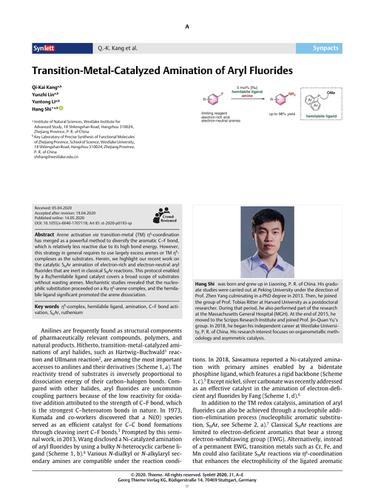Our official English website, www.x-mol.net, welcomes your
feedback! (Note: you will need to create a separate account there.)
Transition-Metal-Catalyzed Amination of Aryl Fluorides
Synlett ( IF 1.7 ) Pub Date : 2020-05-14 , DOI: 10.1055/s-0040-1707118 Hang Shi 1, 2 , Qi-Kai Kang 1, 2 , Yunzhi Lin 1, 2 , Yuntong Li 1, 2
Synlett ( IF 1.7 ) Pub Date : 2020-05-14 , DOI: 10.1055/s-0040-1707118 Hang Shi 1, 2 , Qi-Kai Kang 1, 2 , Yunzhi Lin 1, 2 , Yuntong Li 1, 2
Affiliation

|
Arene activation via transition-metal (TM) η6-coordination has merged as a powerful method to diversify the aromatic C–F bond, which is relatively less reactive due to its high bond energy. However, this strategy in general requires to use largely excess arenes or TM η6-complexes as the substrates. Herein, we highlight our recent work on the catalytic SNAr amination of electron-rich and electron-neutral aryl fluorides that are inert in classical SNAr reactions. This protocol enabled by a Ru/hemilabile ligand catalyst covers a broad scope of substrates without wasting arenes. Mechanistic studies revealed that the nucleophilic substitution proceeded on a Ru η6-arene complex, and the hemilabile ligand significant promoted the arene dissociation.
中文翻译:

芳基氟化物的过渡金属催化胺化
通过过渡金属 (TM) η6 配位的芳烃活化已合并成为一种强大的方法来多样化芳族 C-F 键,由于其高键能,其反应性相对较低。然而,这种策略通常需要使用大量过量的芳烃或 TM η6-配合物作为底物。在此,我们重点介绍了我们最近在富电子和电子中性芳基氟化物的催化 SNAr 胺化方面的工作,这些氟化物在经典 SNAr 反应中是惰性的。该协议由 Ru / hemilabile 配体催化剂启用,涵盖了广泛的底物,而不会浪费芳烃。机理研究表明,亲核取代在 Ru η6-芳烃配合物上进行,并且半稳定配体显着促进了芳烃的解离。
更新日期:2020-05-14
中文翻译:

芳基氟化物的过渡金属催化胺化
通过过渡金属 (TM) η6 配位的芳烃活化已合并成为一种强大的方法来多样化芳族 C-F 键,由于其高键能,其反应性相对较低。然而,这种策略通常需要使用大量过量的芳烃或 TM η6-配合物作为底物。在此,我们重点介绍了我们最近在富电子和电子中性芳基氟化物的催化 SNAr 胺化方面的工作,这些氟化物在经典 SNAr 反应中是惰性的。该协议由 Ru / hemilabile 配体催化剂启用,涵盖了广泛的底物,而不会浪费芳烃。机理研究表明,亲核取代在 Ru η6-芳烃配合物上进行,并且半稳定配体显着促进了芳烃的解离。











































 京公网安备 11010802027423号
京公网安备 11010802027423号